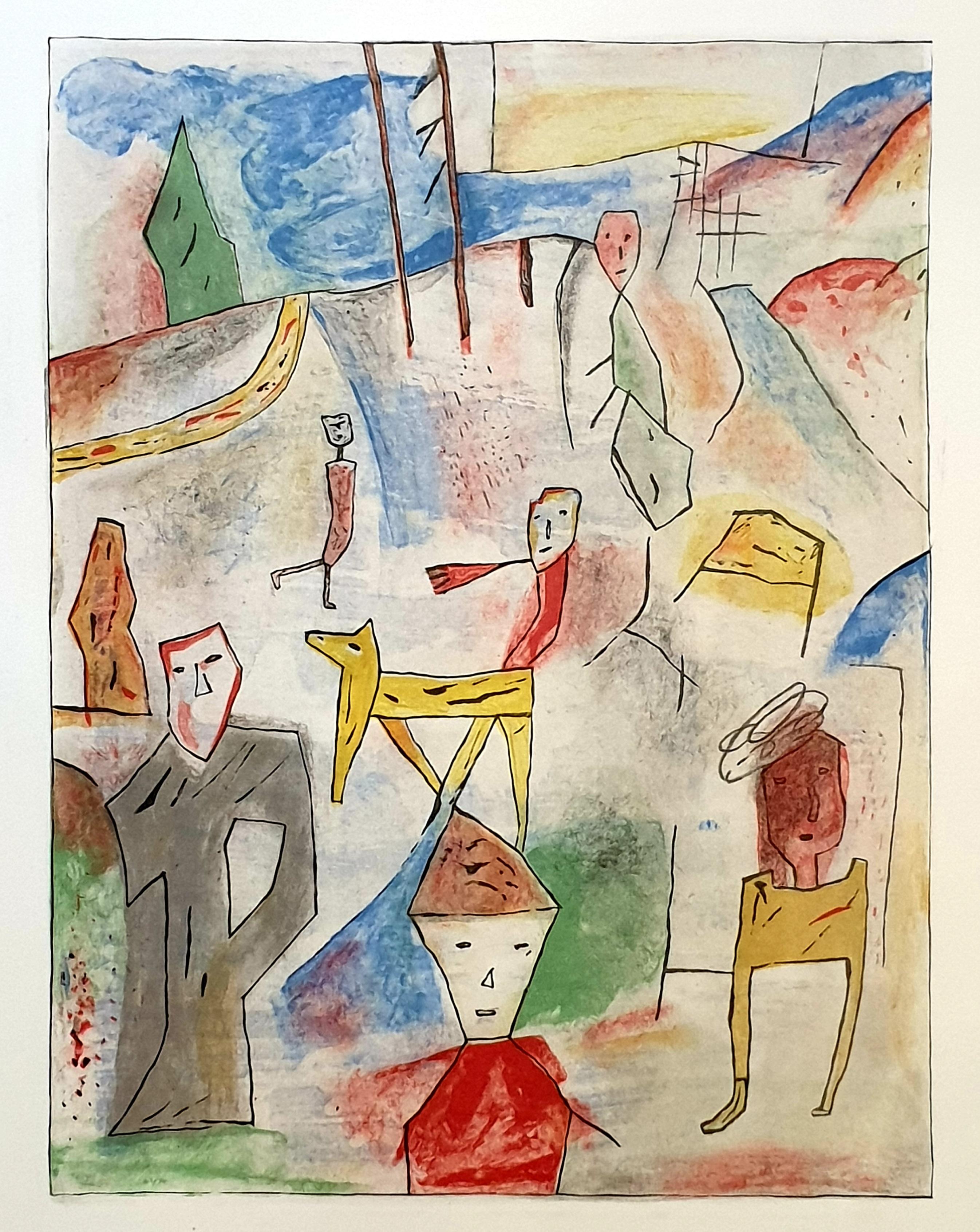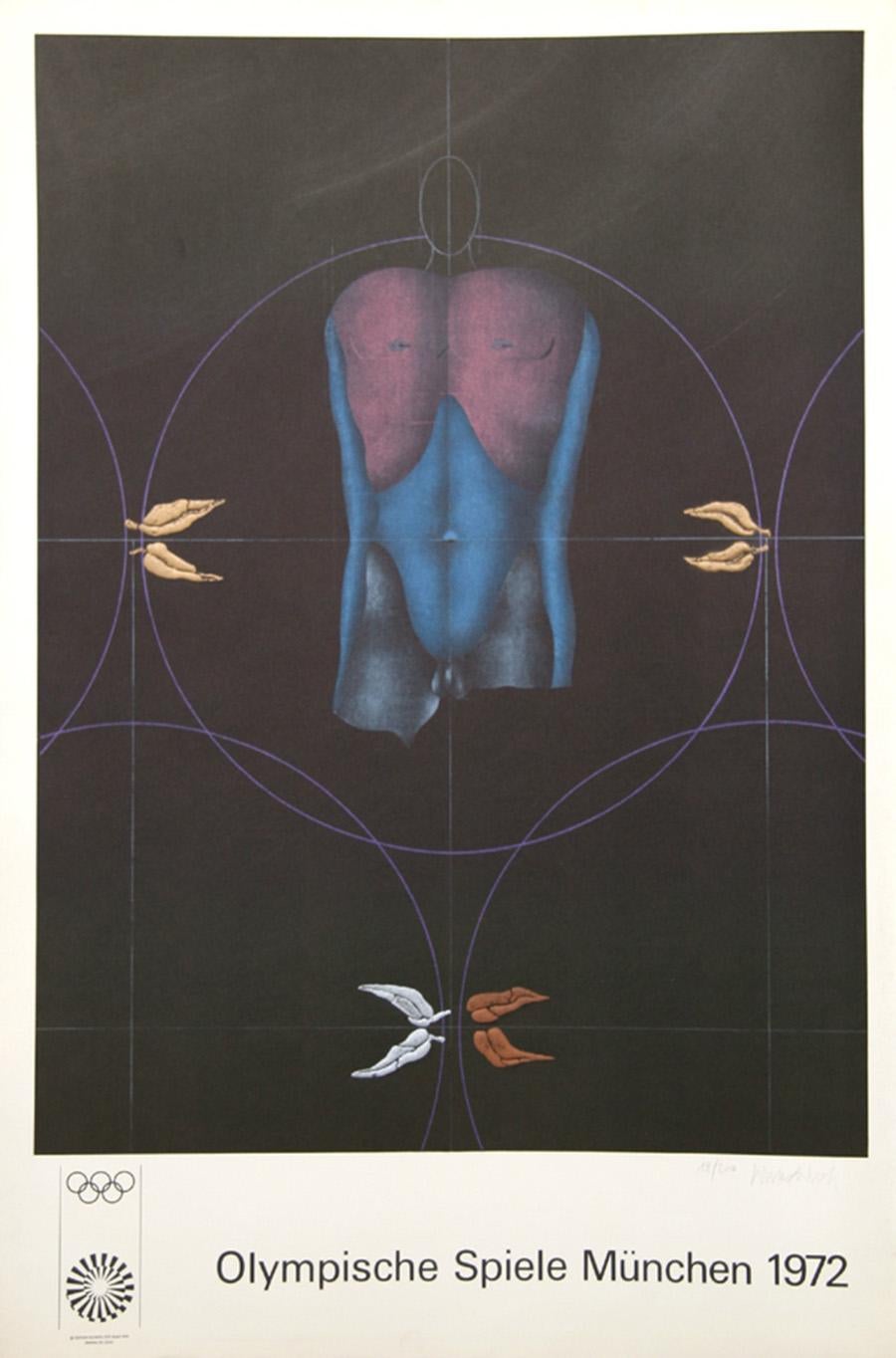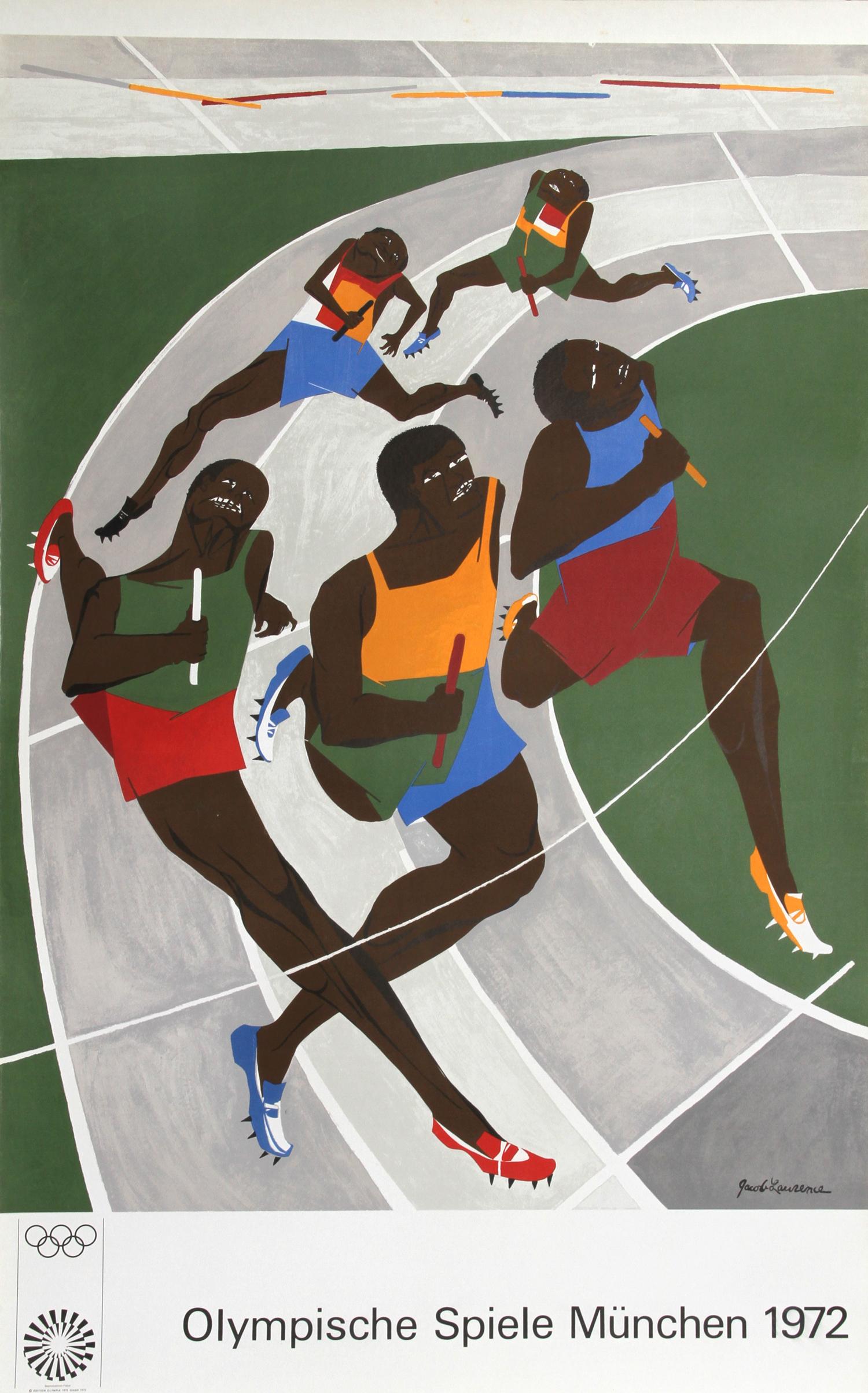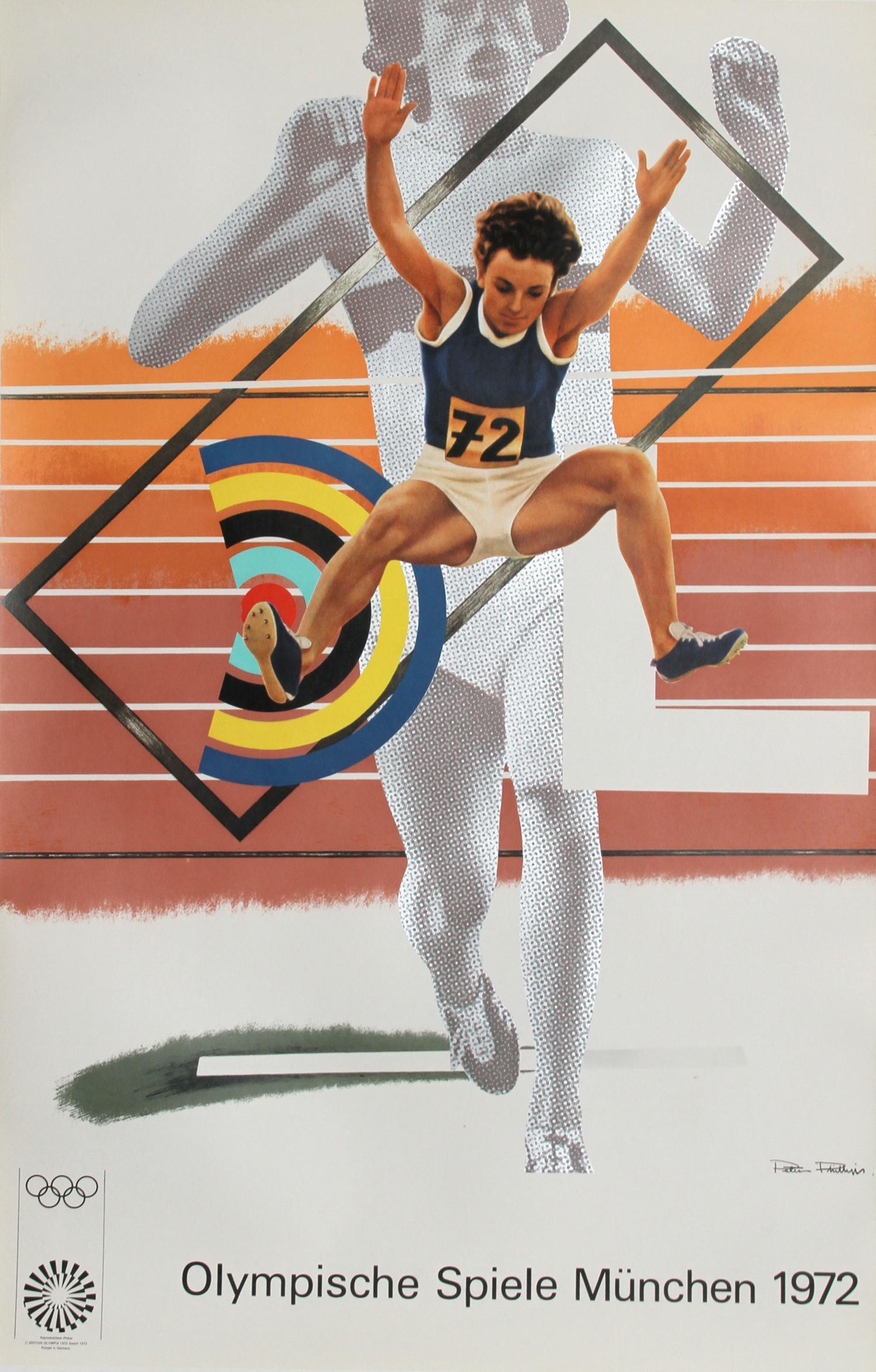Items Similar to 1960's California Pop Art Abstract Expressionist LA Lithograph "About Women"
Want more images or videos?
Request additional images or videos from the seller
1 of 13
John Altoon1960's California Pop Art Abstract Expressionist LA Lithograph "About Women"1965-1966
1965-1966
About the Item
John Altoon (American, 1925-1969)
From the 'About Women' Series.
Color lithograph
1965/66,
Hand signed and editioned in pencil with the chop mark of Gemini G.E.L. publishers
John Altoon (1925 - 1969), an American artist, was born in Los Angeles to immigrant Armenian parents. From 1947–1949 he attended the Otis Art Institute, from 1947 to 1950 he also attended the Art Center College of Design in Los Angeles, and in 1950 the Chouinard Art Institute. Altoon was a prominent figure in the LA art scene in the 1950s and 1960s. Exhibitions of his work have been held at the Museum of Contemporary Art San Diego, Whitney Museum of American Art, New York, Corcoran Gallery, Washington D.C, Fine Arts Museums of San Francisco, The Baxter Museum, Pasadena, and The Los Angeles County Museum of Art (LACMA).
Altoon's work was influenced by the Abstract Expressionism Movement although he is best known for his figurative drawings of the 1960s, with as Leah Ollman describes "a vocabulary of vaguely figurative, botanical and biological forms that he pursued until his death." He was part of the "Ferus group" of artists so called for their association to the Ferus Gallery that operated in Los Angeles in 1957–1966. Some of the other artists included in this group are Edward Kienholz, Larry Bell, Robert Irwin, Billy Al Bengston. He was featured in the Cool School documentary, a film about Altoon and other Ferus Gallery artists such as Walter Hopps and Ed Kienholz, Craig Kauffman, Wallace Berman, Ed Moses, John Altoon, Ed Ruscha and Robert Irwin. many Ferus artists say John was the most fun and friendliest of all, every where everyone liked him. He could charm anyone. Altoon, during his Ferus Gallery years, did the Ocean Park series which depicted an area around Venice and Santa Monica beach towns in California. The series was 18 paintings as well some works he did on paper. It had the direct from brain to hand & brush approach he was known for: the abstracting of nature on his canvas by pushing through a spontaneous approach, freehand biomorphic in design giving us his surrealist interpretation as a direct rendering of the coastal surroundings.
Leah Ollman describes his life a 1999 article in Art in America, "With his outsized personality and reckless intensity, John Altoon loomed large in the L.A. art scene of the '50s and '60s". In the course of his brief artistic career, John Altoon made an explosive impression on the Los Angeles art community of the 1950s and ’60s, in part because of his volatile personality. He produced drawings, paintings, and prints of overt satires, surrealist personal nightmares, and improbable sexual situations. In fact, Altoon frequently used his dreams and fantasies as subjects, influenced by his encounter with Surrealism in his travels through Europe. His renderings had a characteristically misty or ghostly quality, which Altoon achieved by using an airbrush to apply color. Altoon was diagnosed as schizophrenic in his late 30s and suffered bouts of depression and paranoia. From 1962 to 1963 he produced the pop art Advertising Parodies series and large-scale pastels that explored the figure as represented in the media and pop culture, pulling imagery and text from commercial advertisements. In 1965 he worked at the Tamarind Lithography Workshop, which taught a generation of American master printers. Altoon continued to draw throughout his career, creating his Animal and Cowboys and Indians series from 1966 to 1968, in which the comical and sexually explicit implications that abound in his early work "gave way to softer, biomorphic forms that were vaguely sexual and highly fanciful."Irving Blum, partner in the Ferus Gallery, recalls: "If the gallery was closest in spirit to a single person, that person was John Altoon--dearly loved, defiant, romantic, highly ambitious--and slightly mad." Altoon's struggle with mental illness, his big, dark, robust personality and his early death from a heart attack at 44 have, even more than his art itself, come to define his legacy."
- Creator:John Altoon (1925 - 1969)
- Creation Year:1965-1966
- Dimensions:Height: 19 in (48.26 cm)Width: 38 in (96.52 cm)
- Medium:
- Movement & Style:
- Period:
- Condition:good. minor wear. never been framed.
- Gallery Location:Surfside, FL
- Reference Number:1stDibs: LU3829358182
John Altoon (1925-1969) was an artist and commercial illustrator known for loose drawings of botanicals and natural form. His work crosses a hybrid between abstract and figurative, influenced by Abstract Impressionism. Altoon used color and line movement to connect sociopolitical messages with the viewer’s eye. A prominent member of the Ferus Gallery’s group of artists and Wallace Berman’s Semina circle, Altoon was influenced of artists like Pablo Picasso in creating raw, satirical pieces of work. Born in Los Angeles, John Altoon attended the Otis Art Institute, the Art Center College of Design, and the Chouinard Art Institute. His work has been exhibited at the Museum of Contemporary Art San Diego, the Whitney Museum of American Art, New York, and Fine Arts Museums of San Francisco.
About the Seller
4.9
Platinum Seller
These expertly vetted sellers are 1stDibs' most experienced sellers and are rated highest by our customers.
Established in 1995
1stDibs seller since 2014
1,549 sales on 1stDibs
Typical response time: 1 hour
- ShippingRetrieving quote...Ships From: Surfside, FL
- Return PolicyA return for this item may be initiated within 3 days of delivery.
More From This SellerView All
- Large 1960's California Pop Art Abstract Expressionist LA Lithograph John AltoonLocated in Surfside, FLJohn Altoon (1925-1969) UNTITLED, 1966, color lithograph, hand signed in pencil and inscribed trail proof II, sheet 29 ¾ x 41 ¼, printed by Gemini G.E.L.,...Category
1960s Abstract Expressionist Abstract Prints
MaterialsLithograph
- 1960's California Pop Art Abstract Expressionist LA Lithograph "About Women"Located in Surfside, FLJohn Altoon (1925 - 1969), an American artist, was born in Los Angeles to immigrant Armenian parents. From 1947–1949 he attended the Otis Art Institute, fr...Category
1960s Abstract Expressionist Abstract Prints
MaterialsLithograph
- Large Italian Aquatint Etching Francesco Clemente Neo Expressionist Avant GardeBy Francesco ClementeLocated in Surfside, FLFrancesco Clemente (Italian b. 1952), 'This side up / Telemone #2, 1981 Medium: Intaglio hard ground etching, color aquatint, drypoint, and soft-ground etching with chine collé (ha...Category
1980s Abstract Expressionist Abstract Prints
MaterialsDrypoint, Etching, Aquatint, Intaglio
- Michael David, Mugual Indian Star Abstract Expressionist Color Etching PrintBy Michael DavidLocated in Surfside, FLMichael David (b. 1954) Hand signed, Prestige Art blind stamp; edition of 45; 1993 Color Etching on Arches Buff "The Mugual Series" Printed by the artist with master printers Sylvia Roth and Mary Seibert at Hudson River Editions and published by Prestige Art Ltd., Mamaroneck, New York. 22 X 18 framed Michael David Singer; born 1954, is an American painter. Born in Reno, Nevada, David's family relocated to Brooklyn, New York, where he was raised. He attended SUNY Fredonia for one year and in 1976 received a B.F.A. from Parson's School of Design. Michael David is classified as an abstract painter, best known for his use of the encaustic technique, which incorporates pigment with heated beeswax. He is also known for his works in mixed-media figure painting, photography and environmental sculpture. His work is included in the permanent public collections of the Metropolitan Museum of Art, the Guggenheim Museum, the Jewish Museum in New York, the Museum of Contemporary Art in Los Angeles, and the Los Angeles County Museum of Art, among others. In 1976 David, erotic photographer Roy Stuart and Fredonia friend Richie Stotts formed a band called The Numbers, with David on bass. The group was a fixture in New York's early punk rock music scene, playing in clubs alongside punk pioneers Television, Blondie and the Ramones. David also played bass with punk innovators Jerry Nolan of The New York Dolls, Cheetah Chrome of The Dead Boys, Marky Ramone, Peter Gordon, David Van Tieghem and the free-improvisation noise music group Borbetomagus. In 1977, The Numbers were approached by impresario Rod Swenson, who was seeking musicians to form a backing band for singer Wendy O. Williams, whose radical persona he sought to exploit as punk music and performance art. The Numbers became The Plasmatics but the attention David began to gain as an important voice in the art world caused him to leave the band to pursue his burgeoning painting career. David's first one-man show was in 1981 at the historic Sidney Janis Gallery. That year he was awarded a Guggenheim Fellowship, at the time the youngest artist ever to do so, and in 1982 was awarded an American Academy of Arts and Letters prize. He went on to exhibit at galleries worldwide and was represented by Knoedler & Co. for the next 25 years. David is best known for using the encaustic technique of painting, which uses pigment combined with heated beeswax. David built his early career on abstraction and religious iconography, which formed the bulk of his output until 1999. Since then he has also experimented with representational painting and traditional photography. In 2000, he developed the "Chortens" and "Populations" series, about which prominent art historian and critic Donald Kuspit writes: "They are enigmatic works, all the more so because of the way their innumerable details form singularly monumental, intimidating wholes. Dense yet delicate, awesome yet intimate, they convey the fragility as well as grandeur of sheer being. Layer upon layer of paint piles up like layer upon layer of coral, but the textural result is more epic, not to say startling, than any coral island, and virtually any other existing abstract expressionist painting (upon which they are stylistically founded)." In 2001, David developed bi-lateral neuropathy due to being poisoned by gases released by overheated beeswax used in the encaustic process. The disease left him with partial paralysis of his legs, slowing the production of his painting for a number of years. That year, David began painting one of his best-known series, the "fallen Toreadors", inspired by 19th century French Realist painter Édouard Manet's "The Dead Toreador" of 1864. In 1993, David experimented at the "20x24" Polaroid studio in Manhattan, which resulted in a series of portraits of playwright Edward Albee and of friend Jackie Gross, which would become the ongoing "Jackie" series of mixed-media works. When neuropathy rendered him unable to paint during 2003, he returned to the 20x24 camera and shot large-format Polaroids inspired by Caravaggio; nude men and women dressed as Toreadors, and religious imagery. In 2002, David began to develop The Greenhouse Project, an evolving "architectural construct" based on historical American Antebellum greenhouses built using the actual glass negatives sold to starving farmers in the post-American Civil War South. David has indicated that each greenhouse will, through the display of photography and use of social networking, create a forum and exhibit for ideas and artifacts related to civil and human rights; the specifications of each greenhouse particular to the community in which each is built. David's work was reviewed in Artforum and Art in America, and is considered one of the last links to the New York School of painting. David may be the most innovative master of immediate surface since the abstract expressionists. He has acknowledged his debt to Abstract Expressionism, but he has transformed it. Where the abstract expressionist paintings of the forties and fifties seem like modern cave paintings, as their crude, unfocused, often meandering, turbulent painterliness suggests, and as such to reinstate prehistory, David seems to turn the cave into a temple, as his more considered, concentrated, indeed, dense, contemplative painterliness indicates, so that his paintings have the aura of post history. SELECT GROUP EXHIBITIONS 2010-2011 “Post Mammalian Tension, Michael David & Scott Browning”, Bill Lowe Gallery, Atlanta, GA 2006 “Unspoken Connections,” The Lowe Gallery, Santa Monica, CA 2004 The Lowe Gallery, Atlanta, GA 1999 “Waxing Poetic: Encaustic Art in America,” Montclair Art Museum, Montclair, NJ “Forty Years of American Drawings,” Raab Galerie, Berlin, Germany 1997 “Michael David and James Hyde,” Margulies Taplin Gallery, Coral Gables, FL 1996 “Different Sides: Drawings/Photographs/Prints/Paintings/Sculpture,” Knoedler and Company, New York, NY 1994 “Michael David: Paintings / Nicholas Pearson: Sculpture,” Margulies Taplin Gallery, Boca Raton, FL 1991 “Working with Wax: Ten Contemporary Artists,” Tibor de Nagy Gallery, New York, NY 1989 “Projects and Portfolios: the 25th Print National,” The Brooklyn Museum, Brooklyn, NY “Important Works on Paper,” Meredith Long and Company, Houston, TX “New Editions,” Pace Prints, New York, NY 1988 “Golem! Danger, Deliverance, and Art,” The Jewish Museum, New York, NY 1987 “Monotypes,” Pace Editions, New York, NY “Working in Brooklyn / Painting,” The Brooklyn Museum, Brooklyn, NY “Art Against AIDS,” benefit exhibition Knoedler and Company, New York, NY “Jewish Themes: Contemporary American Artists,” Spertus, Chicago, IL 1986 “First Impressions: Recent Monotypes by 15 Artists,” Allan Frumkin Gallery, (Charles Arnoldi, Pat Steir etc) “Saints and Sinners: Contemporary Responses to Religion,” De Cordova Museum, Lincoln, MA “Jewish Themes: Contemporary American Artists,” The Jewish Museum, New York, NY “Public and Private American Prints Today,” Brooklyn Museum, Brooklyn, NY 1985 “A Decade of Visual Arts at Princeton: 1975-1985,” The Art Museum, Princeton University, Princeton, NJ 1984 “Cunningham Dance Benefit,” Leo Castelli Gallery, New York, NY (Robert Rauschenberg, Arman etc) Twelve Abstract Painters, Siegel Contemporary (Elizabeth Murray, Melissa Meyer, Leon Polk Smith etc.) “Small Paintings,” Jeffrey Hoffeld Gallery, New York, NY 1982 “Elaine de Kooning’s Inadvertent Collection,” Elaine Benson Gallery, Bridgehampton, NY 1981 “New Visions,” The Aldrich Museum of Contemporary Art (James Biederman, Louisa Chase,Mel Kendrick etc.) 1980 “Seven Young Americans,” Sidney Janis Gallery, New York, NY (Sean Scully, Thornton Willis...Category
1990s Abstract Expressionist Abstract Prints
MaterialsEtching
- Iranian Israeli Large Aquatint Etching Figurative Abstract Circus Monde BalloonsBy Elie (Eliahu) AbrahamiLocated in Surfside, FLBright colorful abstract circus scene with balloons. Born in 1941 in Sanandaj, Iran and immigrated to Israel at the age of 17. Elie Abrahami began his study of art at the Avni School...Category
20th Century Abstract Figurative Prints
MaterialsAquatint
- Georges Braque Bouquet de Fleurs Lithograph Bold Blue Hand Signed Ltd Ed PrintBy Georges BraqueLocated in Surfside, FLGeorges Braque (French, 1882-1963) Bouquet de Fleurs Lithograph in colors, 1957. Published by Maeght, printed by Mourlot, Paris, France Numbered 166/300 and hand signed in pencil. ...Category
20th Century Modern Figurative Prints
MaterialsLithograph
You May Also Like
- Abstract Expressionist, Art Brut Lithograph, 'A Day Out'.Located in Cotignac, FRAbstract Expressionist lithograph on BFK Rives paper of a late 20th century work by French artist Eliane Larus. A lively and highly colourful lithograph...Category
Late 20th Century Abstract Expressionist Abstract Prints
MaterialsLithograph
- "Seder" original artists proof signed lithograph by Theo TobiasseBy Théo TobiasseLocated in Paonia, COSeder by Tobiasse shows a group of eleven men, woman and children sitting and standing around the Seder table with an orange background. This original lithograph is in good condi...Category
1970s Abstract Expressionist Figurative Prints
MaterialsLithograph
- Olympische Spiele Muenchen by Paul WunderlichBy Paul WunderlichLocated in Long Island City, NYArtist: Paul Wunderlich (1927 - 2010) Title: Olympische Spiele Muenchen Year: 1972 Medium: Lithograph Poster mounted on linen Edition: 3000 ...Category
1970s Abstract Expressionist Abstract Prints
MaterialsLithograph
- Olympische Spiele Muenchen (The Runners) by Jacob LawrenceBy Jacob LawrenceLocated in Long Island City, NYArtist: Jacob Lawrence (1917 - 2000) Title: Olympische Spiele Muenchen (The Runners) Year: 1972 Medium: Lithograph Poster mounted on linen E...Category
1970s Abstract Expressionist Abstract Prints
MaterialsLithograph
- Olympische Spiele Muenchen by Peter PhillipsBy Peter PhillipsLocated in Long Island City, NYArtist: Peter Phillips (1939 - ) Title: Olympische Spiele Muenchen Year: 1972 Medium: Lithograph Poster mounted on linen Edition: 3000 Size:...Category
1970s Abstract Expressionist Abstract Prints
MaterialsLithograph
- Olympische Spiele Muenchen (Foot) by Tom WesselmannBy Tom WesselmannLocated in Long Island City, NYArtist: Tom Wesselmann (1931 - 2004) Title: Olympische Spiele Muenchen (Foot) Year: 1972 Medium: Lithograph Poster mounted on linen Edition:...Category
1970s Abstract Expressionist Abstract Prints
MaterialsLithograph
Recently Viewed
View AllMore Ways To Browse
1960 California
1960s Beach
Cowboys And Indians
Cowboy And Indian Art
Retro Botanical Art
Cowboy Fine Art
Dark Botanical Art
Vintage 50S Women
Cowboys And Indians Vintage
American Indian Lithographs
Lithograph Of American Indian
School Bell Vintage
America By Wallace
Cowboy Pop Art
Botanical School Print
Brain Vintage
50s Vintage Pop Art
Vintage Call Bell






